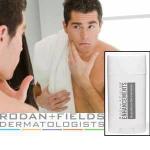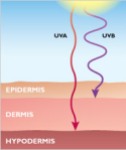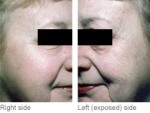by Debi G | Feb 29, 2012
 Melasma is a dark skin discoloration that appears on sun-exposed areas of the face. It is often associated with the female hormones estrogen and progesterone. It is especially common in pregnant women, women who are taking birth control pills (oral contraceptives) and women taking hormone replacement therapy (HRT) during menopause. Melasma doesn’t cause any other symptoms besides skin discoloration but may be of great cosmetic concern.
Melasma is a dark skin discoloration that appears on sun-exposed areas of the face. It is often associated with the female hormones estrogen and progesterone. It is especially common in pregnant women, women who are taking birth control pills (oral contraceptives) and women taking hormone replacement therapy (HRT) during menopause. Melasma doesn’t cause any other symptoms besides skin discoloration but may be of great cosmetic concern.
The Reverse Regimen exfoliates, lightens, brightens and protects your skin for a more even tone and texture. Recognized on Allure Magazine’s A List.
Message me for more information on how you can lighten and brighten your skin without a doctors appointment.
For more information about Melasma visit http://www.ncbi.nlm.nih.gov/pubmedhealth/PMH0012171/
by Debi G | Feb 16, 2012

This Is Sun Damage
Sun damage, also identified as photo damage, refers to how the sun alters the look and feel of the skin. Sun damage is a form of extrinsic aging, which is early aging that is caused by the surroundings. Extrinsic aging is collective, and means that the effects exacerbate with repeated, unprotected contact to the sun.
What Causes Sun Damage?
Sun damage is caused by frequent exposure to damaging ultraviolet (UV) rays. UV is an undetectable form of radiation emitted by the sun. There are two types of UV rays, UVA and UVB. UVA rays penetrate deep into the skin and are the major source of early aging and skin cancer. UVB rays primarily access the surface of the skin and are the key source of sunburns.
How Often Am I Exposed To Harmful UV Rays?
Whether you are walking to your car, driving to work, or simply sitting near a window, you are exposed to harmful UV rays. This type of daily contact is known as secondary UV exposure. Secondary exposure occurs where you least expect it. It can occur in the shade, on cloudy days, even while you are indoors. It is likely that the average individual is exposed to more than 10 hours of indoor UV rays every week. Add to that over 7 hours of outdoor UV rays a week and without a suitable shield, your weekly UV-radiation exposure might total nearly 20 hours. That’s like spending the weekend at the beach without wearing sunscreen .
What Increases the Sun’s Damaging Effects?
We are all vulnerable to the harmful effects of the sun. However, some people may be more at risk than others. People that have sustained burns are definitely in one of the top groups of individuals that are at a higher risk. Below you will see a list of what else can put you in a high risk bracket.
Where you live: If you live closer to the equator, the sun is directly overhead and the UV rays are stronger. Anyone who lives in the mountain regions should look out too. Studies there is a roughly an 8% to 10% increase in UV intensity for each 1,000 feet of increased altitude.
How do you live: Do you enjoy outdoor activities? Remember, sun damage accumulates over time the more you are exposed, the more damaged your skin becomes. Apply sun protection ever time you venture out.
Your Medications: Certain medications, such as antibiotics, cause heightened sensitivity to the sun. Ask your doctor if any of your medications can cause photosensitivity.
Genetics: Are you fair skinned with light hair (red or blond) and freckles? If yes, you are at a high risk of developing sun damage. If you have a family history of skin cancer, take extra measures and use daily sun protection.
Is Sun Damage Dangerous?
The answer is yes. In addition to premature aging of the skin, sun damage also increases your risk of skin cancer. Cosmetic Procedures Cosmetic procedures can be completed for more serious sun damage. It should be done under the direct management of a skilled skin care professional.
-Kovack Laser Institute

Before and After the REVERSE Regimen
For less intrusive Sun Damage, Rodan+Fields offers products that will erase the signs of premature aging, including brown spots, dullness, and sun damage by exfoliating, lightening, brightening and protecting your skin for a more even tone and texture.
Be smart. Wear a hat and use your sunscreen!
Contact me for more information
The material contained on this site is for informational purposes only and is not intended to be a substitute for professional medical advice, diagnosis, or treatment. Always seek the advice of your physician or other qualified health care provider.
by Debi G | Feb 15, 2012
 The sun’s rays make skin look old and wrinkled years before it should. More than 80% of the signs of skin aging in adults are the result of the tans they had as teens before the age of 18. That’s because over time, the sun’s ultraviolet light damages the fibers in the skin called elastin. When these fibers breakdown, the skin begins to sag, stretch, and lose its ability to go back into place after stretching.
The sun’s rays make skin look old and wrinkled years before it should. More than 80% of the signs of skin aging in adults are the result of the tans they had as teens before the age of 18. That’s because over time, the sun’s ultraviolet light damages the fibers in the skin called elastin. When these fibers breakdown, the skin begins to sag, stretch, and lose its ability to go back into place after stretching.
Source:

Contact me for your solution to minimize your sun damage
by Debi G | Feb 13, 2012
 R+F isn’t just for women!! Meet the Micro-Dermabrasion “Stick”…Kinda looks like a stick of deodorant and users love it’s mess free packaging.
R+F isn’t just for women!! Meet the Micro-Dermabrasion “Stick”…Kinda looks like a stick of deodorant and users love it’s mess free packaging.
Great when used as a pre-shaving application to cleanse, smooth and exfoliate the skin….priced perfectly under $40.
Buy for your Guy or for Just Because!
Contact me for yours!
by Debi G | Feb 1, 2012

Yes. And here’s why.
So what’s the difference between these “U” ltra “V” iolet Light Rays
Our skin is concerned with three categories of light rays ultra-violet, visible and infra-red rays. Ultra-violet or UV is divided into three sections according to their wavelengths from the sun to the earth. UV rays effects on your skin by aging of your skin. So why you should regulate your exposure and use sun protection?
1. UVC, shortest from the sun, does not easily reach the earth’s surface due to being absorbed by the ozone layer above the earth. Occasionally articles are written on the ozone depletion and the possible exposure to UVC where only a brief exposure can cause light sunburn. Prolonged exposure to UVC is considered fatal.
2. UVB, long considered the “tanning ray” is strongest in northern hemisphere summer months or when parts of the earth orbit closest to the sun. When the earth is further away from the sun in the northern hemisphere winter months it is harder to get a “suntan” because the rays can not easily reach the earth’s surface. Sunblocks and sunscreens for many years only blocked the UVB rays as science was not clear on the body’s reaction to UVA.
Body’s Reaction to UVB
This ray only has the strength to penetrate the very top layer of your body called the epidermis which has the same thickness as a silk scarf. No blood vessels or nerve endings are present and is composed of keratinocytes (skin cells), basal cells and melanocyte cells. Melanocyte cells synthesize tyrosinase and the pigment melanin that is transferred to the keratinocytes or skin cells for color. UVB rays simulate the melanocyte cells to produce more melanin which is more color known as a suntan or if a very small area known as a freckle, brown or age spot, and chloasma, melasma or hyperpigmentation in medical terms.
 3. UVA, was touted in the 1980’s as the safe ray and sun beds were the rage. Some dermatologist backed this idea as a safe and healthy way to look your best. Since then science has found this ray actually does more damage to the body than UVB. UVA is the same strength year round it does not matter how close or how far away the sun is from the earth. The ray remains the same strength and considered a light X ray penetrating light clothing, wind shields, office windows and hats to name a few. You can test this by putting a color bound book or fabric covered furniture in a sunny window for a few months. You will start to see the color fade as the rays work on the book or furniture. Often women will say they never go out in the sun but their chest is permanently red and wrinkled, their hands look old which I usually categorize as “free-way” or “commuter” aging. A pulled down head visor in a vehicle does not protect your hands on the steering wheel or exposed chest driving into the sun. Car pooling, commuting or traveling congested areas even several times a week is enough to cause aging. When taking the train or plane is the sunlight on your hands or chest? Male skin is thicker “free-way” or “commuter” aging affects them mostly by more brown spots on the exposed side of their face. Living in a sun state or country like Mexico or equator countries provide a constant sunny environment making a daily full spectrum sunblock or sunscreen a necessity.
3. UVA, was touted in the 1980’s as the safe ray and sun beds were the rage. Some dermatologist backed this idea as a safe and healthy way to look your best. Since then science has found this ray actually does more damage to the body than UVB. UVA is the same strength year round it does not matter how close or how far away the sun is from the earth. The ray remains the same strength and considered a light X ray penetrating light clothing, wind shields, office windows and hats to name a few. You can test this by putting a color bound book or fabric covered furniture in a sunny window for a few months. You will start to see the color fade as the rays work on the book or furniture. Often women will say they never go out in the sun but their chest is permanently red and wrinkled, their hands look old which I usually categorize as “free-way” or “commuter” aging. A pulled down head visor in a vehicle does not protect your hands on the steering wheel or exposed chest driving into the sun. Car pooling, commuting or traveling congested areas even several times a week is enough to cause aging. When taking the train or plane is the sunlight on your hands or chest? Male skin is thicker “free-way” or “commuter” aging affects them mostly by more brown spots on the exposed side of their face. Living in a sun state or country like Mexico or equator countries provide a constant sunny environment making a daily full spectrum sunblock or sunscreen a necessity.
Body’s Reaction to UVA

Over 30 years, the left side of this teacher’s face aged faster due to UVA exposure through a window in her classroom. Just compare the two sides! Photos: Professor J. Leyden. Photos not retouched.
UVA shoots through the epidermis and disperses in the dermis the second major layer of your skin. The dermis is called the “true skin” and slows its replacement or renewing rate around the age of 28 years. Skin after this age is considered “mature skin” and damage is not mended as well if at all, fair skin people look in the mirror asking “What happened?”. These rays accelerate the aging process and like new paint on a car in a crowded parking lot years later does not look so great. The skin like paint on a car has to be taken care of and protected. The dermis is composed of collagen, elastin, blood vessels, nerve endings and ground substances (glyco-amino-glycans, mucopoly-saccharides) providing a firm youthful mattress for your skin. Prolonged exposure to UVA cracks and shrinks the collagen and elastin reducing the size of this layer allowing the epidermis (top layer) to start drooping or hanging off the body. Blood vessels become permanently dilated giving a constant red flush to the skin. The few remaining melanocyte cells that are scattered in the dermis can either die making a permanent white spot or become over active leaving a brown spot. There are no lasers or procedure available at this time guaranteeing the removal of these brown spots and some procedures make them worse. The water binding ground substances are less and ineffective making the skin dry. In the end over exposure to this ray can put you in the dermatologist or plastic surgeon’s office faster than any other aggravator. Not to mention the reported deaths from radiation poisoning from tanning beds. Be very careful and wear your sunblock or sunscreen when exposed.
Sunlight regulates our biological clock and provides essential vitamin D. Common sense should be used in regulating your amount of time in the sun.
So the answer is yes. Wear the proper sunscreen daily and for the best protection, apply several times throughout the day.
Please fell free to contact me for more information about our skincare products.
1 Documentation on file at La Roche-Posay.
2 Clinical study: Dr. A. Kligman. 2000 AAD interview entitled “Is Daily Photo-protection a Rational Ideal?”
* Illustrations not to scale.
 Melasma is a dark skin discoloration that appears on sun-exposed areas of the face. It is often associated with the female hormones estrogen and progesterone. It is especially common in pregnant women, women who are taking birth control pills (oral contraceptives) and women taking hormone replacement therapy (HRT) during menopause. Melasma doesn’t cause any other symptoms besides skin discoloration but may be of great cosmetic concern.
Melasma is a dark skin discoloration that appears on sun-exposed areas of the face. It is often associated with the female hormones estrogen and progesterone. It is especially common in pregnant women, women who are taking birth control pills (oral contraceptives) and women taking hormone replacement therapy (HRT) during menopause. Melasma doesn’t cause any other symptoms besides skin discoloration but may be of great cosmetic concern.






